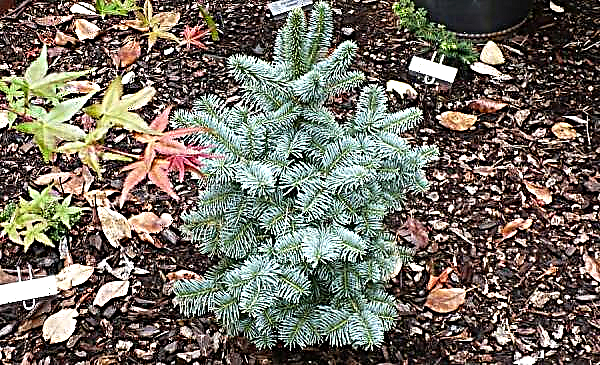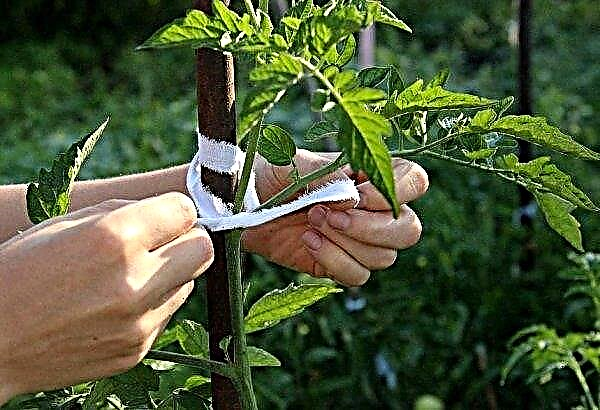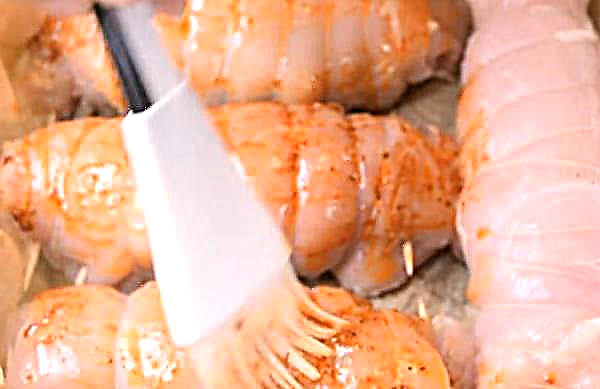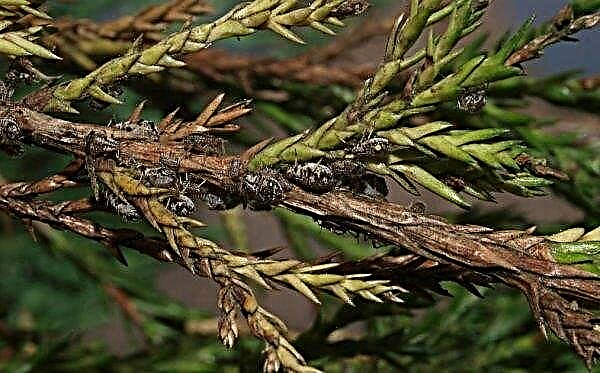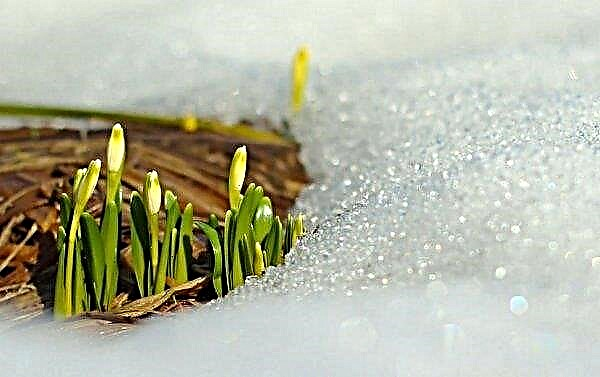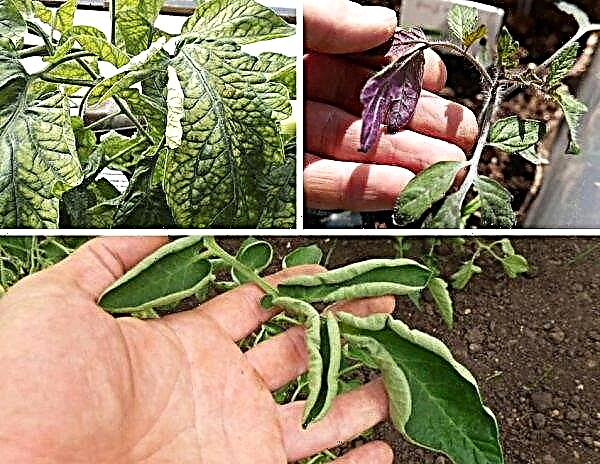Violets are the most popular flowering house plants, therefore it is not surprising that today there are many different varieties that differ from each other not only in the nature of flowering, but also in size and shape of the leaves. From this article you will learn about the popular variety of such flowers, called "Darling", which, due to the relatively unpretentiousness of the growing conditions, are increasingly found on the windowsills of Russian and Ukrainian flower growers.
Botanical description of the plant
Violet Dushechka appeared thanks to the efforts of the famous breeder K. Morev and is characterized by the presence of large, rounded and slightly stratified, semi-double flowers with salmon-pink, slightly wavy petals. The edges of the petals are densely dotted with red dot spraying, which attracts additional attention to the plant. Flower stalk - strong, but short, combines 5-6 buds with medium flowers (diameter not more than 4.5-5 cm). The rosette of the plant is a standard size, flat and compact. The dark green sheet plates in it are pressed tightly against each other, making them look very neat.
Important! With each new stage, the violet flowers will be slightly smaller than the previous ones, therefore, to avoid strong chopping, it is recommended to periodically pluck the buds that are forming, thereby extending the dormant period until the next flowering.
The stem part is slightly expressed, however, as in other varieties of senpolia. A very noticeable advantage of Darling is the frequent and long flowering, which lasts at least two months each time. Under good growing conditions, timely watering and top dressing, a break between flowering “waves” will be minimal.
Violet growing conditions
In order for the violet to please the florist with lush and plentiful flowering, it is important to create all the necessary conditions for it, taking into account the illumination of the location of the pot and the requirements for temperature indicators.
Placement and lighting
Like all senpolis, Dushechka needs a sufficient amount of diffused light, so the windowsills of the western and eastern windows are well suited for its placement. It is also worth considering the absence of drafts in the chosen place, otherwise the flowers of the plant will constantly crumble, without reaching the maximum level of flowering.
To determine if the violet is enough light, it is worth assessing the condition of its leaves. If they reach up and the petioles are constantly lengthening, then it is time to move the pot to a more lighted room. In case of excessive sun exposure, an excess of ultraviolet light will cause a blanching of the flower’s outlet and twisting of its leaf plates down.
Temperature and humidity
A suitable temperature is no less important than adequate lighting, so try to keep the indicators at + 18 ... + 25 ° C, with a possible nightly decrease of no more than 5 ° C. Short-term lowering of temperature values is usually well tolerated by flowers, but with prolonged exposure to cold, flower stalks can crumble.
Did you know? The first talk about violets was massively discussed in 1892, when Baron Walter von Saint-Paul found this flower in the mountains of Africa and sent its seeds to his father. Since then, the widespread cultivation of Saintpaulia began (the plant received this name in honor of its discoverer) as an ornamental plant.
Basic rules for the care of violets at home
Caring for the violet Dushechka at home provides for the implementation of all the same actions as when growing other varieties of this flower: watering, fertilizing, pruning and regular transplanting.
Watering
Timely soil moisture is the key to the well-being of the plant. However, the liquid should be dosed and performed at the same time: in the warm season of the year - in the morning, and in winter - in the evening, but before dusk. Young plants are watered more often than adults, preventing the soil from completely drying out. Instances older than three years moisturize less often: about 1 time in 2-3 days. Senpolia irrigation fluid must be filtered, settled and relatively warm (not lower than + 18 ° C).
Young plants are watered more often than adults, preventing the soil from completely drying out. Instances older than three years moisturize less often: about 1 time in 2-3 days. Senpolia irrigation fluid must be filtered, settled and relatively warm (not lower than + 18 ° C).
Top dressing
Darling positively responds to regular feeding, which is largely due to its frequent and prolonged flowering, which only depletes the substrate. Complex mineral fertilizers for the senpolia, with the obligatory presence of calcium, potassium, magnesium, phosphorus, nitrogen, sulfur, are perfectly suitable for the role of nutritional compositions. The introduction of finished preparations is carried out simultaneously with watering the flower using the root method, with a regularity of once every 10-14 days in the summer and once a month in the winter.
Important! When pouring liquid fertilizer on the Saintpaulia, make sure that it does not get on the leaves of the violet, otherwise they will get burns and wither.
Pruning
Violet Darling needs only sanitary or anti-aging pruning, which is usually done in early spring. In the first case, faded buds, withered or dried leaves are subject to removal, and in the second case, the senpolia is plucked over old leaves, leaving only a young central outlet. In some cases, new stepsons are subject to removal, however, only if they strongly thicken the flower.
Transfer
The transplantation of violet Dushechka is mainly carried out only when the young plant grows from its pot and it needs more space for further development and flowering. In addition, changing the place of growth of Saintpaulia is also relevant in the case of excessive forcing of leaf plates or wilting of a flower, which can signal the decay of the root system.
A planned transplant of violets is performed in late March or early April, preparing a new pot (should be 2-3 cm wider than the old one) and a suitable substrate, from peat, coniferous soil, leaf and sod land, to which it is useful to add perlite or river sand (ratio of components 1: 1: 3: 2: 1). At the bottom of the landing tank, always lay out a 2-3-cm drainage layer of small broken brick (if we are talking about jigging small children, then you can use disposable glasses with crushed foam at the bottom).
Did you know? Violets are not only an element of the decor of the room, but also a natural air purifier in the room (emits volatile phytoncides). Inhalation by a person of the volatile substances of this plant contributes to the normalization of the heart rhythm, the improvement of metabolic and protective processes in the body.
The transplantation process itself is simple, especially if the planned replacement of the pot was its cause: you can move the violet by the transshipment method, simply by adding fresh soil mixture to a new pot. If the transplant is forced and there is a suspicion of rotting of the root system, then you will first have to slightly trim the roots of the flower, leaving only the strongest and healthiest (it is useful to sprinkle the places of cuts with crushed charcoal).
How to propagate at home
Propagation of violet Darling at home is possible in several ways, the simplest of which are considered to be cuttings and dividing the bush.
Cuttings
Healthy leaf plates cut from the second tier act as cuttings when propagating violets. A very sharp knife is used for this, and after the procedure is completed, it remains only to transfer the resulting material to a prepared glass of water for the formation of roots. The own root system of the handle will be formed no earlier than three weeks after separation, after which the leaf can be transplanted into a pot filled with soil.
Important! When the violet leaf is rooted in water, it must be placed in a glass so that only the petiole is in the liquid, and the leaf plate itself remains above the water. Ignoring this recommendation leads to decay of the leaf, that is, damage to planting material.
The soil for the plant and the drainage layer are prepared according to the same rules as for a planned transplant of an adult plant, and after planting the cuttings in a new substrate, you only need to moisten the soil slightly and transfer the plant to a well-lit place, providing it with rest during the first week of adaptation.
Dividing the bush
Dividing the bush is another well-known and often used method of obtaining new violet plants, without damaging an existing instance. In this case, after preparing new planting containers and soil, you should moisten the plant well and, after waiting for the complete absorption of the liquid, carefully remove it from the pot. As soon as you get the flower, it becomes clear how many parts you can divide it (individual children have their own root system).
No special tools are needed to separate from the mother bush, because all parts are excellently broken off. There is also no need for additional shelter for the planted parts, the main thing is to provide them with complete peace for a while.
Growing difficulties
All problems that arise during the cultivation of Dushechka violets are associated with a violation of the requirements for the conditions for its growth and regular care. So, increased humidity often leads to the appearance of white plaque on the surface of leaf plates, which is the main sign of powdery mildew. Hypothermia, insufficient lighting and waterlogging of the plant causes the development of late blight and fusarium, not to mention the different varieties of rot. To eliminate all these problems, first of all, you need to reconsider your actions and normalize watering, additionally treating the plants with Fundazol, Topaz or Bayleton (depending on the nature of a particular ailment). As for pests, the most common inhabitants of Dushechka violet are mealybugs, aphids, and bumps, the appearance of which can also be caused by a violation of flower care. Such insecticides as Actellik, Mospilan, Fitoverm and Aktar are effective in combating them. In rare cases, flies and mosquitoes may appear on the plant, the famous “Karbofos” helps to get rid of them.
As for pests, the most common inhabitants of Dushechka violet are mealybugs, aphids, and bumps, the appearance of which can also be caused by a violation of flower care. Such insecticides as Actellik, Mospilan, Fitoverm and Aktar are effective in combating them. In rare cases, flies and mosquitoes may appear on the plant, the famous “Karbofos” helps to get rid of them.
The norms of use and dosage of drugs for the preparation of working solutions are always noted by the manufacturer on the packaging. Maintaining the growing conditions suitable for Darling, choosing the right feeding regimen and observing the irrigation norms, you will save yourself from all the possible troubles associated with the improper cultivation of senpolia, and the long and lush flowering of violets will be the reward for the efforts made.

